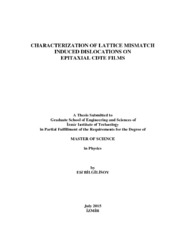Please use this identifier to cite or link to this item:
https://hdl.handle.net/11147/4326| Title: | Characterization of Lattice Mismatch Induced Dislocations on Epitaxial Cdte Films | Other Titles: | Epitaksiyel Cdte Filmlerin Örgü Uyumsuzluğundan Kaynaklanan Dislokasyonların Karakterizasyonu | Authors: | Bilgilisoy, Elif | Advisors: | Selamet, Yusuf | Keywords: | Molecular beam epitaxially CdTe films Defect decoration etching |
Publisher: | Izmir Institute of Technology | Source: | Bilgilisoy, E. (2015). Characterization of lattice mismatch induced dislocations on epitaxial CdTe films. Unpublished master's thesis, İzmir Institute of Technology, İzmir, Turkey | Abstract: | Mercury Cadmium Telluride (HgCdTe) is a widely used material for infrared focal plane array applications. In order to produce high quality infrared detecting material, HgCdTe needs to be grown on large area alternative substrates such as GaAs, GaSb, Si or Ge. GaAs is the best choice as an alternative substrate due to its surface polarity and commercially availability of high quality epi-ready wafers. However, there exists a lattice mismatch between HgCdTe and GaAs. To minimize the detrimental effect of the large lattice mismatch between the two materials, Cadmium Telluride (CdTe) is preferred as a buffer layer for HgCdTe IR material. The lattice mismatch between HgCdTe/CdTe and the GaAs substrate results in a large number of misfit dislocations. Dislocation density of the buffer layer limits and reduces the detector device performance. For this reason, the crystal quality and dislocation analysis of CdTe are examined in detail to produce large area and high performance HgCdTe IR devices.
The aim of this thesis is the characterization of lattice mismatch induced dislocations on epitaxial CdTe buffer layers. CdTe epilayers which were grown on (211)B GaAs by molecular beam epitaxy (MBE) were subjected to two different etch treatments to quantify the crystal quality and dislocation density. The crystal quality was also obtained by using x-ray diffraction (XRD) measurements. The thicknesses of the samples were measured by ex-situ spectroscopic ellipsometry (SE). The surface morphologies of the CdTe buffer layers were analyzed by atomic force microscopy (AFM), scanning electron microscopy (SEM) and Nomarski microscopy before and after wet chemical etching. Vibrational phonon modes distributions of the as-grown and etched samples were examined by Raman spectroscopy mapping. The “triangle” and “trapezoid” shaped etch pits were compared due to the Everson and Nakagawa etching solutions, respectively. Measured etch pit density (EPD) values of “triangle” etch pits were found in 0.3x108 – 3.8x108 cm-2 range and “trapezoid” shaped etch pits were found in 0.03x108 – 0.6x108 cm-2 range for samples. Cıva Kadmiyum Tellür (HgCdTe), kızılötesi fokal düzlem dizini uygulamaları için en yaygın kullanılan malzemedir. Yüksek kalitede kızılötesi algılayıcı malzeme üretebilmek için HgCdTe geniş alanlı GaAs, GaSb, Si veya Ge gibi alt-tabanlar üzerine büyütülmelidir. Yüzey polaritesinden ve yüksek kalitede hazır alt-tabanların ticari olarak bulunmasından dolayı GaAs alt-taban olarak en iyi tercihtir. Ancak; HgCdTe ve GaAs arasında örgü uyumsuzluğu mevcuttur. Bu iki malzeme arasındaki büyük örgü uyumsuzluğunun hasar verici etkilerini en aza indirmek için Kadmiyum Tellür (CdTe) HgCdTe malzemesinde tampon katman olarak tercih edilmektedir. HgCdTe/CdTe ve GaAs arasındaki örgü uyumsuzluğu çok sayıda dislokasyona yol açar. Tampon katmandaki dislokasyon yoğunluğu detektör performansını kısıtlar ve azaltır. Bu nedenle, geniş alanlı ve yüksek performanslı HgCdTe kızılötesi cihazlar üretmek için CdTe malzemesinin kristal kalitesi ve dislokasyon analizi detaylı olarak incelenmelidir. Bu tezin amacı, epitaksiyel CdTe tampon katmanların üzerinde örgü uyumsuzluğunun sebep olduğu dislokasyonların karakterizasyonudur. Moleküler demet epitaksi (MBE) ile (211)B GaAs üzerine büyütülen CdTe katmanların kristal kalitesi ve dislokasyon yoğunluğunun belirlenmesi için iki farklı aşındırma tekniği uygulanmıştır. Kristal kalitesi ayrıca X-ışını kırınımı (XRD) ölçümleri kullanılarak da elde edilmiştir. Örneklerin kalınlıkları spektroskopik elipsometre (SE) ile ölçülmüştür. CdTe tampon katmanların yüzey yapıları atomik kuvvet mikroskobu (AFM), taramalı elektron mikroskobu (SEM) ve Nomarski mikroskobu ile ıslak kimyasal aşındırma öncesi ve sonrasında analiz edilmiştir. Büyütülen ve aşındırılan örneklerin titreşimli fonon mod dağılımları Raman spektroskopi haritalama ile incelenmiştir. Everson ve Nakagawa aşındırma karışımları sonucunda sırasıyla oluşan “üçgen” ve “yamuk” şekilli aşındırma kusurları karşılaştırılmıştır. Ölçülen aşındırma çukur yoğunluğu (EPD) değerleri, “üçgen” aşındırma çukurlarında 0.3x108 – 3.8x108 cm-2 aralığında ve “yamuk” aşındırma çukurlarında 0.03x108 – 0.6x108 cm-2 aralığında bulunmuştur. |
Description: | Thesis (Master)--Izmir Institute of Technology, Physics, Izmir, 2015 Includes bibliographical references (leaves: 109-116) Text in English; Abstract: Turkish and English xv, 116 leaves |
URI: | http://hdl.handle.net/11147/4326 |
| Appears in Collections: | Master Degree / Yüksek Lisans Tezleri |
Files in This Item:
| File | Description | Size | Format | |
|---|---|---|---|---|
| T001342.pdf | MasterThesis | 6.95 MB | Adobe PDF |  View/Open |
CORE Recommender
Page view(s)
248
checked on Apr 21, 2025
Download(s)
326
checked on Apr 21, 2025
Google ScholarTM
Check
Items in GCRIS Repository are protected by copyright, with all rights reserved, unless otherwise indicated.